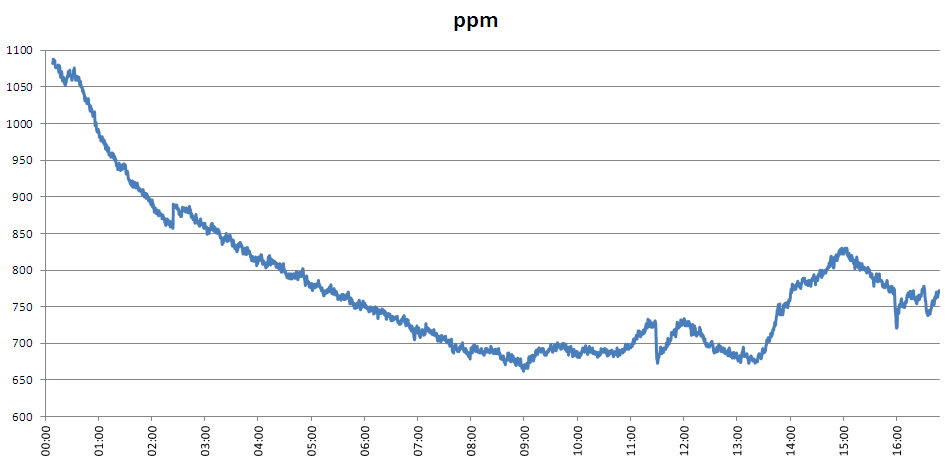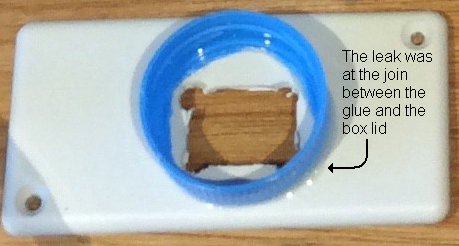I want to test a hypothesis that if I start with initially dry soil, then add a small quantity of water (and some microbes on a small piece of damp soil), I will end up with an escalating production of CO2: the small quantity of water will allow some microbes to consume organic material in the soil, producing CO2 and water. The additional water will make more of the soil damp, allowing the microbes to spread and consume more organic material, until eventually all of the soil is damp.
Based on observing the experiment described in the “Second Attempt” log entry, in which I started with 36ml of water and most of the lower part of the soil was obviously dry to begin with, and the very lowest part still looks dry now (4 weeks later), I think that this process will take several weeks to run.
To begin with, I want to check that completely dry soil does not release CO2. I took 325g of dry soil and placed it in a bottle with the CO2 sensor attached. The CO2 level began at about 1100ppm. Over the course of 3.5 hours I was very surprised to see the CO2 level decrease to 850ppm. What could be the reason for this? One possibility that sprang to mind was that the apparatus had a leak, and the CO2 level in the room was decreasing. To test this I removed the CO2 sensor from the bottle at the end of the experiment and it quickly went back up to over 1000ppm, so a leak can be ruled out as the explanation.
Another possible explanation is that the dry soil had come from a radiator, so it was warm (I estimate no more than 40C) when it went into the bottle. Is it possible that as the soil cools it absorbs CO2 from the air? Or could the temperature or pressure be affecting the sensor reading? Both of these seem plausible: I have read that some minerals adsorb gases when cooled and release them when heated (this is how adsorption pumps work - these have been proposed as a highly reliable way of compressing the atmosphere of Mars for use as a CO2 supply using few moving parts and with focused solar heating as the energy source); the CO2 sensor does not claim to a be highly accurate, and is influenced by environmental factors.
UPDATE 8th January 2018:
After a couple of days the CO2 level in the bottle containing dry soil was down to 650ppm. I decided to add the water (12 ml) and watch what happened to the CO2 level. I had expected that the CO2 level would increase gradually over the next few weeks. To my surprise there was a sudden increase over the next few minutes - it went up to 1600ppm quickly, then climbed more slowly. 9 hours later it was at 2300ppm. It is as though adding the water triggered an immediate release of CO2 from the soil. Could it be that gas adsorbed onto soil particles is released when it gets wet?
If my interpretation of these experiments is correct (I’m not sure yet whether it is), then it means that I can greatly reduce the initial level of CO2 in a sealed bottle by setting up the bottle outside (where the CO2 level is lower than inside), by adding the soil warm and keeping it warm for about 30 minutes, and by waiting for about 30 minutes after I add water to the soil before closing the bottle, so that the initial release of CO2 from the soil escapes from the bottle.
UPDATE 13th January 2018:
My attempt to measure the change in CO2 level in a sealed bottle containing dry soil with 12ml of water and some soil microbes added is hampered by three issues. Firstly, I haven't yet checked my apparatus for leaks - I haven't seen any results which make me think it leaks, but I'm not certain because I haven't explicitly tested this. Secondly, I've found that there is a daily variation in CO2 level in the bottle which I believe is correlated with the temperature in the room. This can be seen in the graph below:

I turn my heating off when I go to bed - shortly before midnight last night - and the CO2 level began to drop shortly afterwards. At weekends I turn my heating on in the morning - shortly after 10am this morning - which is when the CO2 level began to rise. I believe that the amount of CO2 adsorbed by the soil is temperature dependent. When the soil warms it gives off CO2, when it cools it adsorbs again.
Thirdly, the CO2 sensor has a feature called Automatic Baseline Correction (ABC). Some of the documentation for the MH-Z14A says: "...sensor itself do zero point judgement and automatic calibration procedure intelligently after a continuous operation period. The automatic calibration cycle is every 24 hours after powered on". The documentation says that the ABC function is not suitable for greenhouses and that I should shut down the automatic calibration function. The English translation of the documentation doesn't explain how to do this, so I've deliberately not left the sensor powered on for 24 hours so that ABC does not happen. I believe that the idea behind ABC is that if the sensor is used in a situation where the CO2 level regularly goes down to the outdoor CO2 level (which is about 400ppm), the sensor will automatically calibrate itself against this, by looking for the lowest reading over the course of a day. There is some discussion of the feature in a slightly different product (the MH-Z19) here: https://github.com/letscontrolit/ESPEasy/issues/466
Today I found out that the MH-Z19 has commands to turn ABC on and off, they can be found in this file from the ESPEasy project on GitHub:
https://github.com/TD-er/ESPEasy/blob/mega/src/_P049_MHZ19.ino
Then I discovered the Chinese documentation for the MH-Z14A here:
http://style.winsensor.com/pro_pdf/MH-Z14A.pdf
and confirmed with the help of google translate that the same command (command 0x79) works with the MH-Z14A.
The following sequence of bytes turns ABC off:
0xFF 0x01 0x79 0x00 0x00 0x00 0x00 0x00 86
and this command turns it on:
0xFF 0x01 0x79 0xA0 0x00 0x00 0x00 0x00 E6
I'm going to issue the 'ABC off' command whenever I use the sensor. I'm going to stop this current experiment and connect the CO2 sensor to a bottle containing no soil and monitor it for a day - I would expect the CO2 level to remain constant. This will help to check whether or not the apparatus leaks, and whether the variation in CO2 level shown in the graph above really is down to adsorption and release from the soil. Once I've done this, I'll redo this experiment and leave the sensor connected for a longer period.
UPDATE 20th January 2018:
I ran the sensor overnight attached to an empty bottle, and the CO2 level inside went down overnight (see graph below).

To be sure that the reading wasn't being affected by temperature, I made a note of what the CO2 level was at a temperature of 16.1C in the evening (1064 ppm), then looked again in the morning when the temperature had risen back up to 16.1C - it was 700ppm, so the apparatus had a leak.
A simpler way of testing for a leak that didn't occur to me up until this point was to put the apparatus upside-down in a jug of water while gently squeezing the bottle, being careful not to release my grip and accidentally suck water into the CO2 sensor.
I found a small hole in the glue joint where the bottle lid was glued onto the plastic box that holds the sensor (see photo).

The epoxy glue that I am using doesn't stick very well to the plastic box (or the bottle lid), and there was a crack beneath the glue where the glue meets the plastic box. I suspect that the action of screwing and unscrewing the sensor onto bottles - which requires applying pressure to the sides of the bottle lid and flexing it a little - had caused the crack. After drying everything thoroughly, I removed the lid from the box, and removed the old glue.
Before applying more glue, to help the glue hold more strongly, I roughened the plastic box lid very thoroughly with sand-paper - I had already done this before, but I made sure to make it even rougher this time. I also roughened round the edge of the bottle lid where it attaches to the box lid. I used more glue this time. I think that a more flexible glue, and a glue that adheres better to plastic, would be better than the epoxy glue I'm using.
Because this leak affected some of the experiments I've done, it affects my interpretation of some of the results. I'm no longer sure about the idea that soil adsorbs and releases CO2 as the temperature changes. Changes in temperature in the room that the experiment was running in are also correlated with changes in CO2 concentration - in the day when I'm in the room I have the heating on, and also exhale CO2. Overnight the heating is off and at the same time the CO2 level gradually drops because I'm not in the room.
I leak tested the re-glued apparatus first in the water jug, then overnight with a bottle containing an elevated level of CO2. It seemed fine - the CO2 level remained constant overnight (see graph below). I believe that the initial drop from 1400ppm to 1270ppm that occurs before 00:00 hours is because the CO2 sensor had previously been in a higher concentration environment, so it took time to reach equilibrium with the bottle. Since any leak rate is proportional to the difference in CO2 concentration between the inside and the outside of the bottle, it would be sensible to redo this leak test at a much higher CO2 concentration.

 will.stevens
will.stevens
Discussions
Become a Hackaday.io Member
Create an account to leave a comment. Already have an account? Log In.